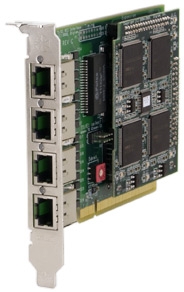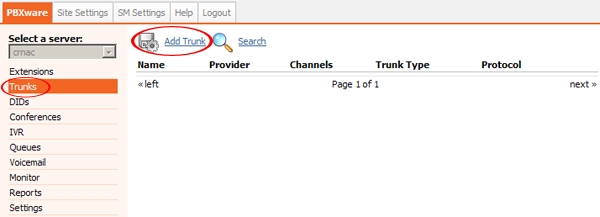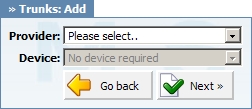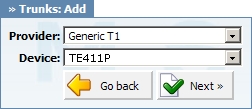¶ Introduction - How to use TE411P card with PBXware
This "How to" is written as general guide on how to use the TE411P card with PBXware. It covers the most common tasks required to have your TE411P card working efficiently.

an example of TE411P card
¶ Requirements
Install TE411P card into PBXware server.
1. Set the jumper on your TE411P card to to set operation mode (T1 or E1).
2. Make sure to power off the PBXware server properly.
3. Open the server.
4. Insert the TE411P card into the free PCI slot.
5. Tighten the screw.
6. Close the server.
7. Connect the T1/E1 port to the service providers port.
8. Boot up the PBXware server.
- Conclusion: If everything is done as above described you should have successfully inserted your TE411P into the PBXware server.
¶ Creating Trunks
STEP ONE: Creating Trunk.
1. Navigate to "Trunks". Click on "Add Trunk".

Creating Trunks
2. The standard options window will be shown below.

3. Select "Provider". "Generic T1" or "Generic E1" depends on how the TE411P is configured, see requirements. In this example we used "Generic T1" .
4. Select "TE411P" from "Device" list.

5. Click on the "Next" button.
STEP TWO: Trunk values.
1. Enter values into the required field text boxes.
REQUIRED FIELDS:
Name:
Enter a name for the trunk being created.
Emergency Trunk:
If the trunk provider supports dialing of emergency services, please select "Yes".
[image:trunks.add.prov.dev.TE411P.jpg|image|Creating Trunks]]
an example with details filled in
2. Click on the "Save" button.
OPTIONAL FIELDS:
Channels:
Single channel or a range of channels being configured.
Group:
Every ZAPTEL trunk needs to belong to a group. Selecting any group will enable this trunk. In addition, PBXware auto selects the next available group and groups already used will not show in the select box.
FXS Kewlstart:
Receive audio/COR on an FXS kewlstart interface (FXO at the channel bank).
Country:
Select the trunk location here.
E164:
The international public telecommunication numbering plan.
Available options:
- Yes
- No
- N/A
International dialing code:
Enter the number required to make international phone calls from your country.
3. Restart the PBXware server by clicking "Restart" located at top right corner on the web interface.
¶ Glossary
- DHCP = Dynamic Host Configuration Protocol (DHCP) is a communications protocol that lets network administrators manage and automate the assignment of Internet.
- E1 = European format for digital transmission. E1 Wide-area digital transmission scheme used predominantly in Europe that carries data at a rate of 2.048 Mbps. E1 lines can be leased for private use from common carriers.
- HUB = A common connection point for devices in a network.
- IP Address = Internet Protocol address.
- Local = A local area network (LAN) is a computer network covering a local area, like a home, office or small group of buildings such as a college.
- LAN = Local Area Network.
- PIN = Personal Identification Number.
- Remote = Network devices that are managed or controlled from a network system other than the system to which they are directly connected.
- Router = A device that forwards data packets from one local area network (LAN) or wide area network (WAN) to another.
- Switch = Network device that selects a path or circuit for sending a unit of data to its next destination.
- T1 = A standard for digital transmission in North America. A digital transmission link with a capacity of 1.544 Mbps (1,544,000 bits per second.) T1 lines are used for connecting networks across remote distances. Bridges and routers are used to connect LANs over T1 networks.
- UAD = User Agent Device.
- VoiceMail = The electronic transmission of voice messages over the Internet. The messages are stored on a computer until the recipient accesses and listens to them.
- WAN = Wide Area Network.
- Web Interface = A web interface is the system of controls with which the user controls a device.